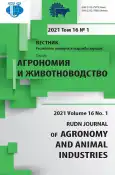Longevity of Ulmus pumila L. in protective afforestation on semi-desert lands of the Astrakhan Zavolzhye
- Authors: Lepesko V.V.1, Rybashlykova L.P.2
-
Affiliations:
- Bogdinskaya research agroforestry experimental station
- Federal Research Center of Agroecology, Complex Reclamation and Protective Afforestation of the Russian Academy of Sciences
- Issue: Vol 16, No 1 (2021)
- Pages: 77-85
- Section: Protective afforestation
- URL: https://journal-vniispk.ru/2312-797X/article/view/315466
- DOI: https://doi.org/10.22363/2312-797X-2021-16-1-77-85
- ID: 315466
Cite item
Full Text
Abstract
The article provides a predictive assessment of longevity of Ulmus pumila L. stands in the Astrakhan Zavolzhye. The effi and expediency of renewable logging for rejuvenation and increasing the longevity of plantings in the semi-desert were confi The classifi of ecotopes of the Astrakhan Zavolzhye on suitability for cultivation of protective and shadow elm plantings on pasture lands was developed and presented. In the Caspian region, Ulmus pumila became widespread in forest reclamation of semi-desert lands in the 1950s. Since then, till the beginning of the 1990s, Bogdinskaya research agroforestry experimental station laid on the sandy massifs about 1 thousand hectares of Ulmus pumila L. plantings, which currently amounts to 18…24 %. The long-term practice of using protective shade Ulmus pumila umbrellas has shown their signifi ecological effect on functioning pastures. The aim of the research was to develop an improved technology for creating long-lived protective shade stands of Ulmus pumila on degraded pastures of the Astrakhan Zavolzhye. The research was carried out using generally accepted methods of stand forest taxation by A.P. Anuchin (1961), 1. Bitvinskas (1974) and A.S. Manaenkov (2001). Soil conditions were studied by drilling sounding to 3 m depth. The results of the research revealed that the longevity of wood species in the dry-steppe zone was determined mainly by two factors: productive moisture in the soil and salinity level. The most favorable growing conditions for Ulmus pumila were unsalted (to a depth of at least 3 m) brown sandy soils, sandy loam soils, dark-colored swale soils with periodic redistributed accumulation of moisture. In arid conditions of the Astrakhan Zavolzhye in island plantations (group of trees, “umbrellas”, 0.5…1 ha parts of forest area) and optimal growing conditions without logging and reforestation, Ulmus pumila lives up to 60…70 years.
About the authors
Vladimir Vasilievich Lepesko
Bogdinskaya research agroforestry experimental station
Author for correspondence.
Email: bossharabali@mail.ru
candidate of Agricultural Sciences, leading researcher, Bogdinskaya research agroforestry experimental station
1, BOS st., Kharabali, Astrakhan region, 416010, Russian FederationLudmila Petrovna Rybashlykova
Federal Research Center of Agroecology, Complex Reclamation and Protective Afforestation of the Russian Academy of Sciences
Email: ludda4ka@mail.ru
candidate of Agricultural Sciences, leading researcher, laboratory of protective afforestation and phytomelioration of low-yielding lands
97, Universitetsky av., Volgograd, 400062, Russian FederationReferences
- Manaenkov AS, Kulik AK. Zakreplenie i oblesenie peskov zasushlivoj zony [Consolidation and afforestation of dry zone sands]. Volgograd: VNIALMI publ.; 2016. (In Russ).
- Rusakova EG, Zabolotnaya MV. Basic wood species of the forest resources of Astrakhan region. Natural sciences. 2011; (1):22—31. (In Russ).
- Lepesko VV. A brief outline of the history of afforestation in the North-Western and Eastern Caspian region. Scientific-agronomic journal. 2018; (1):57—59. (In Russ).
- Tyutyuma NV, Bulakhtina GK, Kudryashov AV, Kudryashova NI. Meliorative efficiency of shrub coulisse on arid pastures of the South of Russia. Arid ecosystems. 2020; 26(1):62—68. doi: 10.24411/19933916-2020-10084 (In Russ).
- Sizemskaya ML, Sapanov MK. The modern condition of ecosystems and strategy of adaptive nature management in Northern Pricaspian semi-desert. Arid ecosystems. 2010; 16(5):15—24. (In Russ).
- Sapanov MK. Environmental implications of climate warming for the northern Caspian region. Arid Ecosystems. 2018; 8(1):13—21. doi: 10.1134/S2079096118010092
- Lepesko VV, Belyaev AI, Pleskachev YN, Fomin SD, Pugacheva AM, Rybashlykova LP. Monitoring the state and ecological ameliorative effect of tree and shrub coulisse and row plantings on pastures in the arid conditions of the northern Caspian. IOP Conference Series: Earth and Environmental Science. 2019; 341:012103. doi: 10.1088/1755-1315/341/1/012103
- Kasyanov FM. Protective forest plantations for increasing productivity of meadows and pastures. In: Vinogradov VV. (ed.) Agrolesomelioratsiya [Agroforestry]. Moscow: Lesnaya promyshlennost’ publ.; 1979. p. 132—148. (In Russ).
- Erusalimskii VI, Rozhkov VA. Multifunctional role of protective forest plantations. Dokuchaev Soil Bulletin. 2017; 88:121—137. (In Russ). doi: 10.19047/0136-1694-2017-88-121-137
- Geyer WA, Iriarte L, Cunningham R. Ulmus pumila L. seed source performance in Kansas. Arid Ecosystems. 2007; 13(32):69—79. (In Russ).
- Su H, Li Y, Liu W, Xu H, Sun OJ. Changes in water use with growth in Ulmus pumila in semiarid sandy land of northern China. Trees. 2014; 28(1):41—52. doi: 10.1007/s00468-013-0928-3
- Wesche K, Walther D, von Wehrden H, Hensen I. Trees in the desert: reproduction and genetic structure of fragmented Ulmus pumila forests in Mongolian drylands. Flora — Morphology, Distribution, Functional Ecology of Plants. 2011; 206(2):91—99. doi: 10.1016/j.flora.2010.01.012
- Kryuchkov SN, Mattis GY. Lesorazvedenie v zasushlivykh usloviyakh [Afforestation in arid conditions]. Volgograd: VNIALMI publ.; 2014. (In Russ).
- Ozolin GP. Wood and shrub species used in protective afforestation of the south-eastern regions of the country. In: Vinogradov VV. (ed.) Agrolesomelioratsiya [Agroforestry]. Moscow: Lesnaya promyshlennost’ publ.; 1979. p.148–160. (In Russ).
- Karandina SN, Erpert SD. Klimaticheskoe ispytanie drevesnykh porod v Prikaspiiskoi polupustyne [Climatic testing of wood species in the Caspian semi-desert]. Moscow: Nauka publ.; 1972. (In Russ).
Supplementary files










